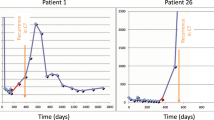Abstract
Postoperative CA19-9 elevation after pancreatic cancer resection suggests recurrence but can also occur in benign conditions. This study aimed to investigate the interpretation of postoperative CA19-9 elevation after pancreatic cancer surgery in terms of cancer recurrence. A cohort of patients undergoing pancreatectomy for pancreatic cancer at our hospital was included. Among them, 52 patients exhibited postoperative CA19-9 elevation without radiological evidence of recurrence. These patients were evaluated with follow-up CA19-9 measurements. The CA19-9 increase rates were calculated based on the first elevation and the follow-up measurement. The association between the CA19-9 increase rate and tumor recurrence was assessed. Patients with a CA19-9 increase rate of ≥ 30% had a significantly higher frequency of recurrence within 3 months compared to those without such an increase (p = 0.0002). Multivariate analysis demonstrated that a CA19-9 increase rate of ≥ 30% was an independent risk factor for recurrence (odds ratio 8.17, p = 0.0309). The CA19-9 value at the first elevation (p = 0.1794) and at the follow-up measurement (p = 0.1121) were not associated with recurrence. After the first postoperative CA19-9 elevation, the CA19-9 increase rate based on follow-up measurements can serve as a predictive factor for tumor recurrence.





Similar content being viewed by others
Data availability
The datasets generated during and/or analysed during the current study are available from the corresponding author on reasonable request.
References
Ducreux M, Cuhna AS, Caramella C et al (2015) Cancer of the pancreas: ESMO clinical practice guidelines for diagnosis, treatment and follow-up. Ann Oncol 26(Suppl 5):v56–v68
Daamen LA, Groot VP, Besselink MG et al (2022) Detection, treatment, and survival of pancreatic cancer recurrence in the Netherlands. Ann Surg 275:769–775
Berger AC, Garcia M, Hoffman JP et al (2008) Postresection CA 19–9 predicts overall survival in patients with pancreatic cancer treated with adjuvant chemoradiation: a prospective validation by RTOG 9704. J Clin Oncol 26:5918–5922
Rieser CJ, Zenati M, Hamad A et al (2018) CA19-9 on postoperative surveillance in pancreatic ductal adenocarcinoma: predicting recurrence and changing prognosis over time. Ann Surg Oncol 25:3483–3491
Albert MB, Steinberg WM, Henry JP (1988) Elevated serum levels of tumor marker CA19-9 in acute cholangitis. Dig Dis Sci 33:1223–1225
Murakami M, Nagai Y, Tenjin A et al (2018) Proposed cut-off value of CA19-9 for detecting pancreatic cancer in patients with diabetes: a case-control study. Endocr J 65:639–643
Narimatsu H, Iwasaki H, Nakayama F et al (1998) Lewis and secretor gene dosages affect CA19-9 and DU-PAN-2 serum levels in normal individuals and colorectal cancer patients. Cancer Res 58:512–518
Bassi C, Marchegiani G, Dervenis C et al (2017) The 2016 update of the International Study Group (ISGPS) definition and grading of postoperative pancreatic fistula: 11 Years After. Surgery 161:584–591
Society JP, Classification of Pancreatic Carcinoma (Fourth English edition) (1996) Kanehara, Tokyo
James D, Brierley MKG (2017) Christian Wittekind, International Union Against Cancer (UICC): TNM Classification of Malignant Tumours, 8th edn. Wiley-Blackwell, Oxford
Azizian A, Rühlmann F, Krause T et al (2020) CA19–9 for detecting recurrence of pancreatic cancer. Scient Rep. https://doi.org/10.1038/s41598-020-57930-x
Castellanos JA, Merchant NB (2014) Intensity of follow-up after pancreatic cancer resection. Ann Surg Oncol 21:747–751
Godhi S, Godhi A, Bhat R et al (2017) Colorectal cancer: postoperative follow-up and surveillance. Indian J Surg 79:234–237
Guven DC, Sahin TK, Yildirim HC et al (2021) A systematic review and meta-analysis of the association between circulating tumor DNA (ctDNA) and prognosis in pancreatic cancer. Crit Rev Oncol Hematol 168:103528
Tempero MA, Arnoletti JP, Behrman S et al (2010) Pancreatic adenocarcinoma. J Natl Compr Canc Netw 8:972–1017
Acknowledgements
None.
Author information
Authors and Affiliations
Contributions
All authors contributed to the study conception and design. Material preparation, data collection and analysis were performed by HI, and YT. The first draft of the manuscript was written by HI and all authors commented on previous versions of the manuscript. All authors read and approved the final manuscript.
Corresponding author
Ethics declarations
Competing interests
The authors have no competing interests to declare.
Ethics approval
The current study was performed in compliance with the Declaration of Helsinki, and was approved by the ethical committee of our hospital (approval number 22507).
Informed consent
Informed consent was obtained on a paper basis from each patient enrolled in this study.
Additional information
Publisher's Note
Springer Nature remains neutral with regard to jurisdictional claims in published maps and institutional affiliations.
Supplementary Information
Below is the link to the electronic supplementary material.
Rights and permissions
Springer Nature or its licensor (e.g. a society or other partner) holds exclusive rights to this article under a publishing agreement with the author(s) or other rightsholder(s); author self-archiving of the accepted manuscript version of this article is solely governed by the terms of such publishing agreement and applicable law.
About this article
Cite this article
Imamura, H., Tomimaru, Y., Kobayashi, S. et al. Diagnostic impact of postoperative CA19-9 dynamics on pancreatic cancer recurrence: a single-institution retrospective study. Updates Surg 76, 479–486 (2024). https://doi.org/10.1007/s13304-024-01758-x
Received:
Accepted:
Published:
Issue Date:
DOI: https://doi.org/10.1007/s13304-024-01758-x




